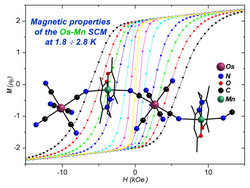Magnets down to the molecular level
Single-molecule magnets (SMM) are polynuclear metal-organic assemblies that behave like atomic sized magnets. Included in category of quantum magnets are single-chain magnets (SCMs) that represent molecular wires. The purpose of the EU-funded VOLURAD (Single-molecule magnets based on the orbitally-degenerate spin centers and stable organic radicals complexes) project was to study polynuclear metal complexes. The primary objective was to assemble molecules with magnetic properties that might be easily controlled and applied to information storage and processing. A crucial part of the work was the synthesis of cyanometallate precursors, elaborating new improved protocols. The compounds have been structurally and magnetically characterized. One of the important achievements of the project has been the synthesis of a number of interesting new magnetic materials studied for the first time. These materials typically consisted of paramagnetic 3d-metal ions, surrounded by radical ligands. The results have significance for many fields, from chemistry to nanotechnology. Perhaps the most immediate practical impact will be on information storage and processing, contributing to European leadership in this technology sector as well as strengthening of the collaborative research contacts between Russia and the EU. Data collected will enable physicists to understand the principles of slow magnetic dynamics. The research effort has been multidisciplinary, involving specialists in chemistry and physics, as well as nanotechnology. The project results have been reported at international conferences: SPIN-2014 and the Nikolaev’s Conference-contest in December 2014. Several papers have been published in peer-reviewed journals. Also a part of the results were included in a chapter in the book titled ‘Osmium: synthesis, characterization and applications’ (2015, Nova Science Publishers).



